Recent Articles
Popular Makes
Body Types
2020 GMC Acadia Road Test and Review
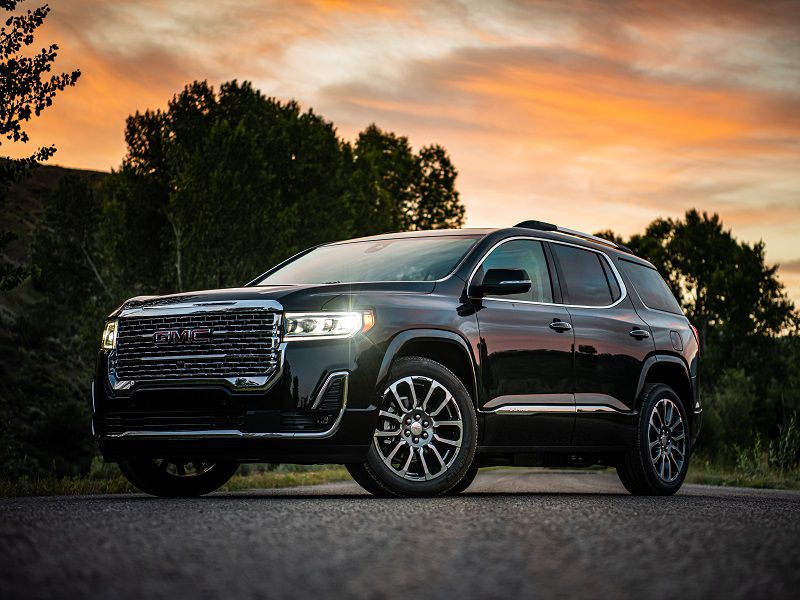
2020 GMC Acadia Denali Black Front Three Quarter ・ Photo by GMC
Most of today’s seven-passenger crossovers follow a familiar formula: tons of interior space, a gently rounded body, and a smooth ride. These models tend to be big and mild-mannered, and they’re great family cars.
That said, if you’re looking for something more interesting and less bulky, let us introduce you to the 2020 GMC Acadia. Newly updated this year with tougher styling details, improved fuel economy, and some new features, the Acadia is one of the smaller crossovers with a decently usable third row. It has less space than its Chevrolet Traverse cousin — but for folks who don’t need maximum interior volume, the Acadia delivers more of an SUV vibe, while the Traverse can feel like a minivan with swing-out doors. Let’s go over the details.
What's New This Year
The GMC Acadia first appeared as a 2007 model, and it entered its current generation in 2017. The 2020 model year brings a comprehensive mid-cycle refresh that emphasizes the Acadia’s SUV-like flavor while also bringing mechanical enhancements and other upgrades.
The biggest changes are under the hood. A new 2.0-liter turbocharged four-cylinder engine is now available, slotted between the carryover 2.5-liter four-cylinder and 3.6-liter V6. And all three engines receive a new, more fuel-efficient nine-speed automatic transmission to replace last year’s six-speed. Cosmetically, the front end becomes blockier, paying homage to GMC’s iconic pickup trucks — particularly on the off-road-themed AT4 trim level, the new name for last year’s All Terrain model. A redesigned center console creates more storage space and some improved materials, while a new infotainment system brings an improved interface and sharper graphics. And newly available features include a hands-free power liftgate, a head-up display, a rearview camera mirror, and power-folding exterior mirrors.
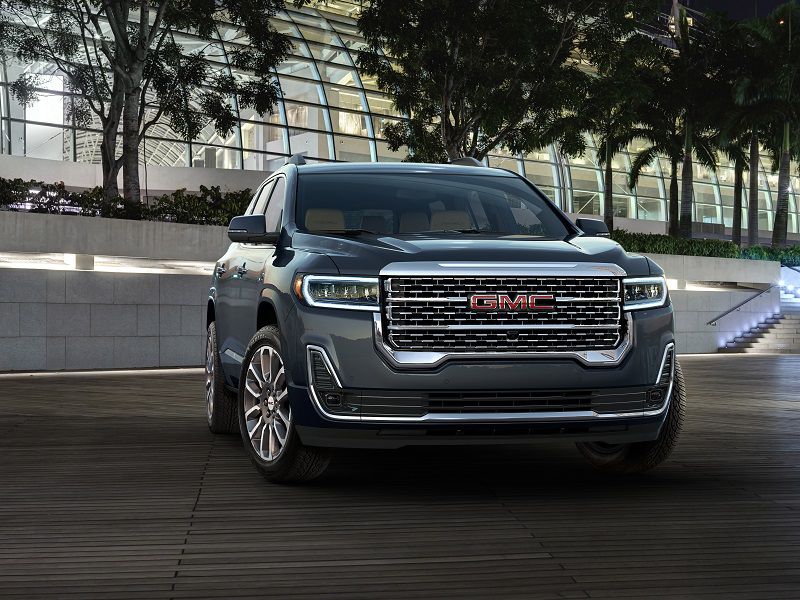
Photo by GMC
Pricing and Trim Levels
The base Acadia SL costs $29,800 and is available only with the 2.5-liter engine and front-wheel drive, though it’s otherwise decently equipped. Standard features include an 8-inch infotainment screen, blind-spot monitoring with a rear cross-traffic alert, rear parking sensors, three-zone automatic climate control, keyless entry with push-button starting, five USB ports, and a leather-wrapped steering wheel.
But the SL is rarely available at dealerships, so nearly all Acadia customers must pay an extra $4,000 for the similarly equipped SLE. The SLE does give you a choice of engines — the base four-cylinder or the V6 with front-wheel drive, or the V6 or the turbocharged four-cylinder with all-wheel drive. Our pick is the SLT ($39,700), which has the turbo standard along with leather upholstery, a hands-free power liftgate, and a power driver’s seat. It’s also the cheapest trim to offer key safety gear like automatic emergency braking and a lane-departure warning — part of a $1,295 option package. The off-road-themed AT4 starts at $42,200 while the maximum-luxury Denali starts at $46,300, both sold only with the V6 engine. Unfortunately, only the Denali offers adaptive cruise control and a more advanced automatic emergency braking system.
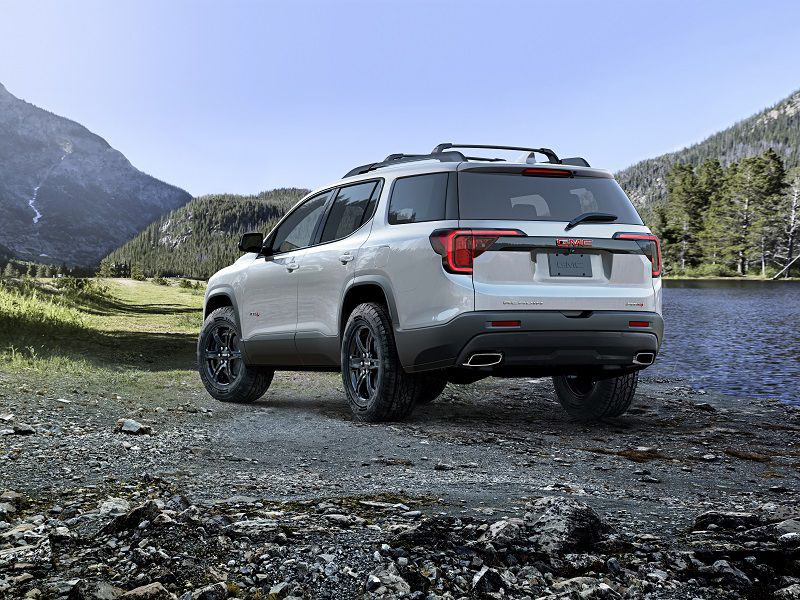
Photo by GMC
Styling and Design
GMC's best-selling vehicle is the Sierra full-size pickup truck, and the brand’s truck focus extends to the Acadia crossover, especially with this year’s revised styling. The 2020 Acadia has an even more truck-like front end than before, with an upright rectangular grilled and rectangular new headlights. Squared-off wheel wells and an upright profile also help distinguish the Acadia from its competitors, though its gently curved taillights could be at home on any crossover. Overall, the Acadia’s exterior design pays homage to trucks without being over-the-top trucky.
Inside, the cabin looks and feels sturdy without coming across as cheap. The dashboard is made up of blocky elements with rounded-off edges, and the design is both cohesive and user-friendly. This year’s new push-button gear selector is a controversial choice, but we appreciate that it frees up extra console storage compared to a conventional shifter. Also, it automatically selects Park when you turn off the vehicle. The newly upgraded infotainment system has clear, crisp graphics and responds quickly to inputs. Despite some upgrades this year, some lower-grade plastics remain, and you won’t find jaw-dropping luxury flourishes.
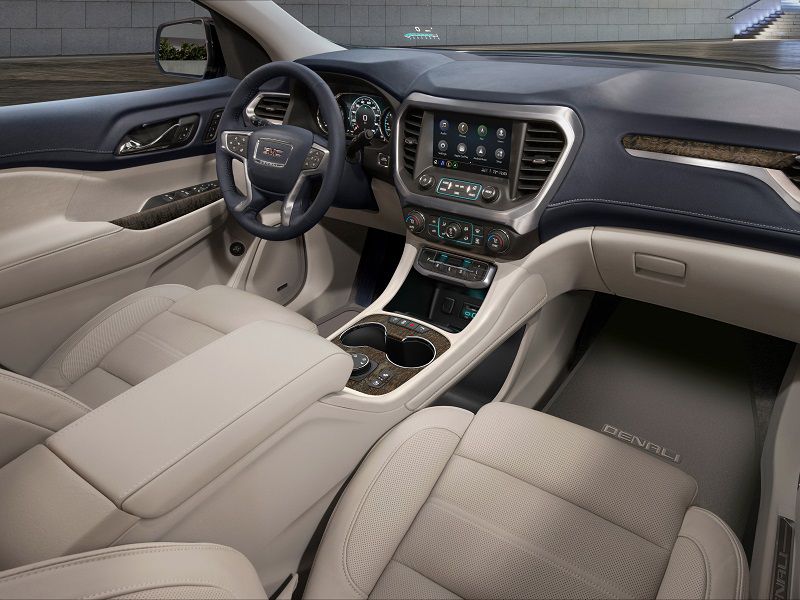
Photo by GMC
Passenger Space and Comfort
Unlike the first-generation Acadia, the current model doesn’t have a cavernous interior. Folks looking for maximum stretch-out space without crazy bulk might be best served by the eight-passenger Honda Pilot or its five-passenger variant, the Honda Passport. That said, the Acadia can be quite comfortable, particularly in the supportive, generously padded front seats, though heavyset folks might wish the seats were wider. The second row doesn’t have extra-generous legroom, but the seat is well-shaped and nicely cushioned. You can get a three-person bench seat like our test vehicle's, or separate captain's chairs.
The AT4 model we tested didn’t include that trim level’s optional third-row seat (it’s standard on other Acadias), but we’ve tried it out in the past and found it to be usable but on the small side. Even some competitors squeeze in more legroom. Even so, we see little reason not to choose the option; having the third row creates extra flexibility in a pinch, and it’s easy to just keep the seat folded flat when no one would be using it.

Photo by GMC
Cargo Capabilities
Limited cargo space behind the available third-row seat means that you’ll need to fold it down often, reducing seating capacity to four or five. There’s just 12.8 cubic feet of volume behind the third row, smaller than most economy sedans’ trunks, and barely half what you get in a Chevrolet Traverse. Specs are more competitive (though still well behind the standout Traverse) with the third row folded down: 41.7 cubic feet behind the second row, and 79.0 cubic feet behind the front seats.
For extra hauling ability, the Acadia is rated to tow up to 1,000 pounds with the base 2.5-liter engine, 1,500 pounds with the 2.0-liter turbo, and 4,000 pounds with the V6. Several competitors can tow more than even the V6 Acadia, but that’s still a decent figure for a crossover.
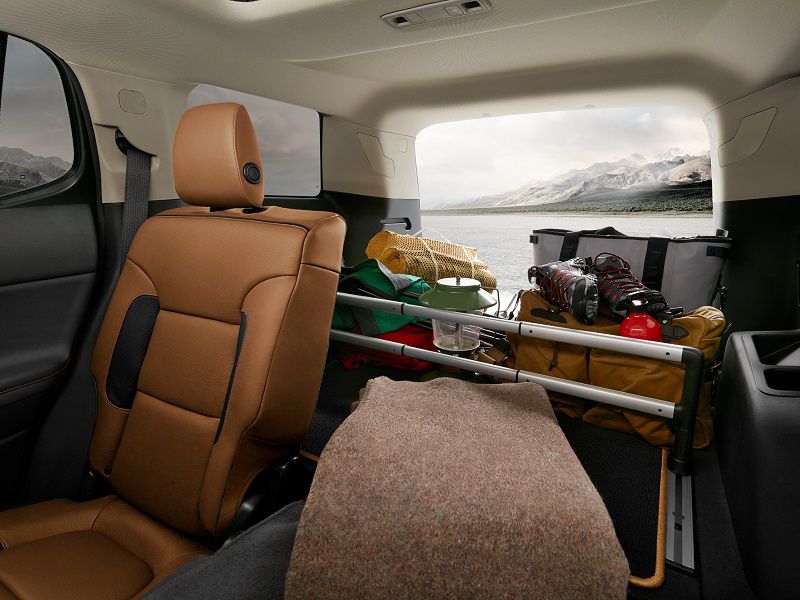
Photo by GMC
Doesn't Drive Like a Truck
Even though the Acadia looks like an old-school SUV, its driving manners are purely crossover — and a good crossover at that. Drivers will enjoy a smooth, quiet ride and decently responsive handling. You won’t get the extra agility of a Mazda CX-9 or Ford Explorer, which are the “sports cars” of the three-row crossover segment. But never does the Acadia feel big and ponderous. It helps, as we’ve mentioned, that it’s physically smaller than some of its competitors as well.
The Acadia's base 2.5-liter four-cylinder engine packs just 193 horsepower and 188 lb-ft of torque. That's low for a mid-size crossover, which is why most Acadias come with either the V6 or the new turbo. The 2.0-liter turbo makes 230 hp and 250 lb-ft of torque — still not amazing if you’re looking for maximum performance, but enough to make acceleration agreeably swifter and quieter for ordinary conditions. The powerhouse 3.6-liter V6 makes 310 hp and 271 lb-ft of torque and brings the richer sound typical of six-cylinder engines. All engines share a smooth-shifting nine-speed automatic transmission.
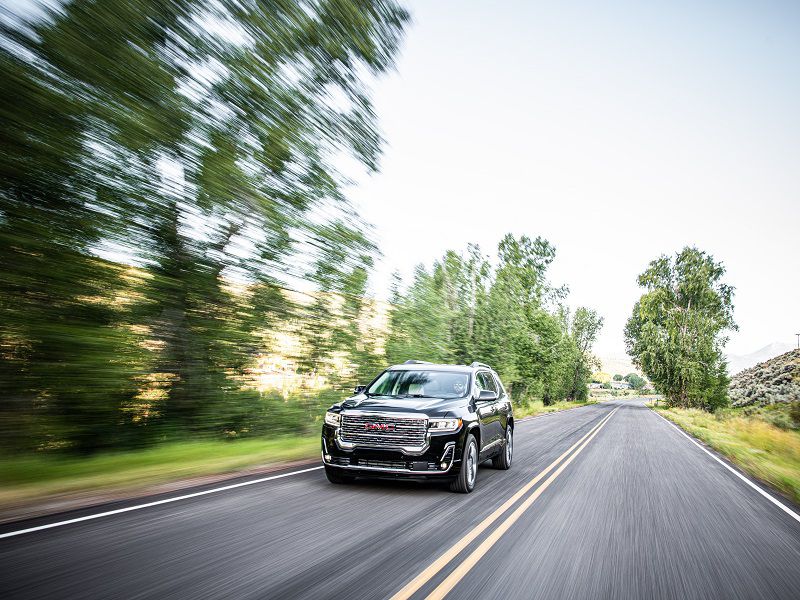
Photo by GMC
Improved Fuel Economy
The new turbo engine is the 2020 Acadia’s fuel economy leader, making this GMC one of the thriftier three-row crossovers available — even though it's noticeably more powerful than the Acadia's base engine. The EPA pegs the turbocharged Acadia at 21 mpg in the city, 28 mpg on the highway, and 24 mpg overall with front-wheel drive and 1 mpg less with all-wheel drive.
The new nine-speed automatic, which replaces last year’s six-speed, improves EPA ratings on the 2.5-liter and 3.6-liter engines by about 1 mpg. That’s because with more gear ratios, a transmission can better balance an engine's acceleration and fuel efficiency. The 2.5-liter Acadia, available only with front-wheel drive, manages 21 mpg city/27 mpg highway/23 mpg overall. The front-drive V6 scores 19 mpg city/27 mpg highway/22 mpg overall, while AWD drops those figures by about 1 mpg. We averaged about 22 mpg in our AT4 test vehicle, which is sold only as an AWD V6, putting our results just ahead of the EPA’s estimates. All engines accept regular-grade fuel.
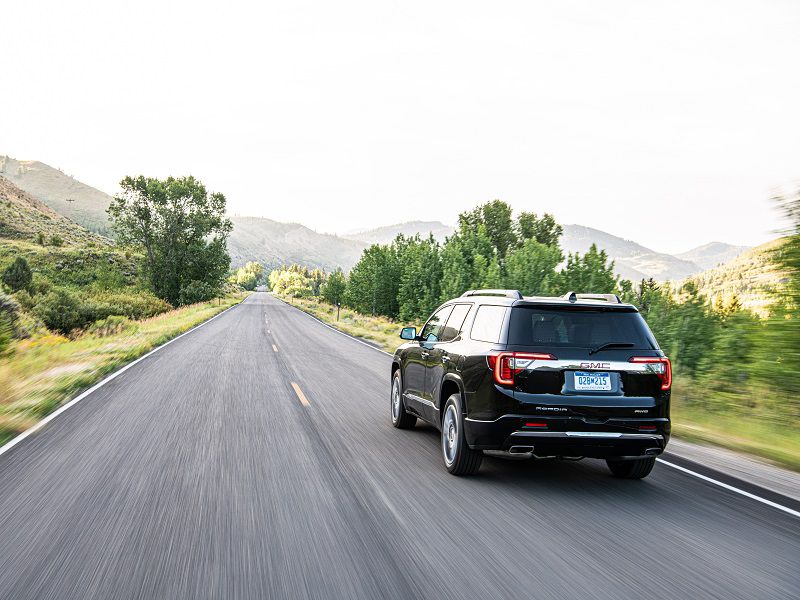
Photo by GMC
Notable Competitors
The Acadia can be a tougher-looking alternative to popular family-focused crossovers like the Honda Pilot and Chevrolet Traverse, or a more sensible alternative to the Jeep Grand Cherokee and Toyota 4Runner SUVs. In this middle ground, the Acadia’s closest competitors are the slightly larger Kia Telluride and Ford Explorer; between the two, the Telluride is roomier, less expensive, and more luxurious, while the Explorer is more agile and fuel-efficient. The Telluride is a particular standout for the money, both as a family car and as a stylish SUV-looking crossover. The Honda Passport could also be a compelling Acadia alternative if you’re not looking for three rows of seats.
If you’re attracted to the Acadia because you want seven seats without a lot of bulk, the leading competitors would be the Toyota Highlander and Kia Sorento, though neither shares the Acadia's buff design. The Sorento is smaller and significantly less money than the Acadia; the Highlander is slightly larger and similarly priced when comparably equipped. Note that most of the Acadia’s competitors have standard safety equipment that's a costly upgrade on the GMC.
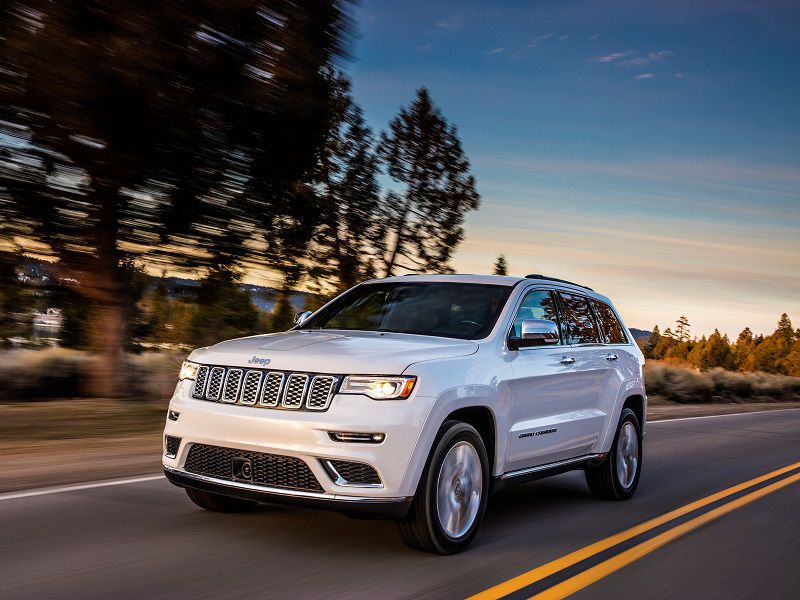
Photo by Jeep
Conclusion
The 2020 GMC Acadia looks like a truck while offering the driving manners, fuel economy, and interior space of a car-based crossover. And if you don’t want a huge vehicle, you’ll appreciate that it’s a little smaller than most of its competitors.
The Acadia’s elevated price point means that it’s something of a luxury model in its class, especially considering that you need a high-end model to get increasingly common safety and driver-assistance technology. At the same time, its interior doesn't lead the class for opulence. But the Acadia’s fundamental strengths, plus its new features and improved fuel economy, can still make it an excellent mid-size crossover for the right buyer.
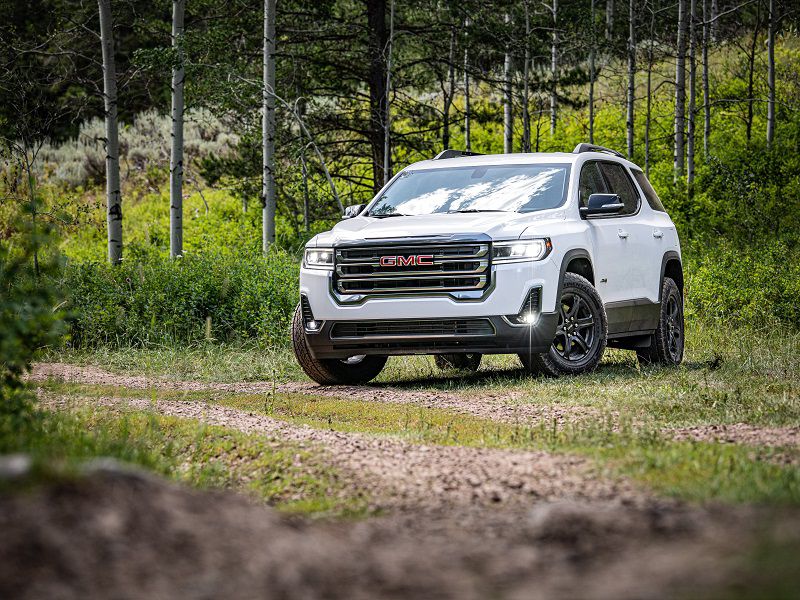
Photo by GMC